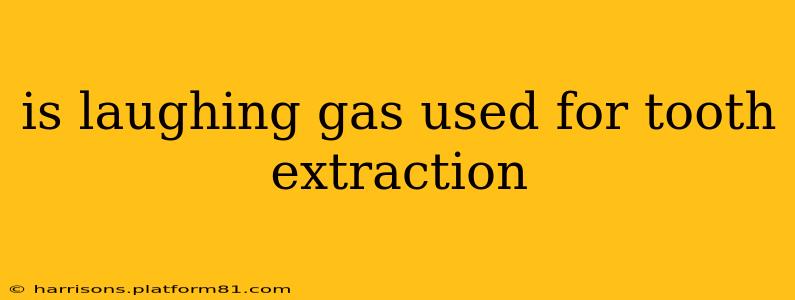Yes, laughing gas, also known as nitrous oxide, is commonly used in dentistry, including during tooth extractions. It's a safe and effective sedative that helps patients relax and feel less anxious during dental procedures. While it doesn't completely numb the area like a local anesthetic (like lidocaine), it significantly reduces pain perception and discomfort, making the experience more tolerable. This makes it a valuable tool for managing dental anxiety, particularly in patients who feel apprehensive about tooth extractions.
How Does Laughing Gas Work During Tooth Extraction?
Nitrous oxide works by affecting the central nervous system. When inhaled, it interacts with receptors in the brain, producing a feeling of relaxation and euphoria. The effect is relatively quick-acting, and the sedation wears off quickly after the procedure concludes, minimizing any lingering drowsiness. It's important to note that laughing gas isn't a general anesthetic; you'll still be awake and aware during the extraction, although significantly less stressed and anxious. The dentist will typically use a local anesthetic alongside the nitrous oxide to ensure the extraction itself is painless.
What are the Benefits of Using Laughing Gas During a Tooth Extraction?
-
Reduces Anxiety and Fear: This is arguably the biggest benefit. Many people experience significant anxiety before and during dental procedures. Nitrous oxide effectively eases this anxiety, making the entire experience more comfortable and manageable.
-
Pain Reduction: While not a replacement for local anesthetic, nitrous oxide can significantly reduce the perception of pain, making the extraction less uncomfortable.
-
Rapid Onset and Offset: The effects of laughing gas are quick to start and dissipate, meaning you can resume normal activities soon after the procedure. This is a significant advantage over other sedatives with longer-lasting effects.
-
Safe and Effective: Nitrous oxide has a long history of safe use in dentistry and is generally well-tolerated. However, as with any medical procedure, there are potential side effects, which we'll discuss below.
What are the Potential Side Effects of Laughing Gas?
While generally safe, nitrous oxide can cause some side effects in some patients. These are usually mild and temporary, including:
-
Nausea: Some patients experience nausea during or after the procedure.
-
Dizziness: Dizziness or lightheadedness is possible, especially immediately after the gas is discontinued.
-
Headache: A mild headache is a rare side effect.
-
Allergic Reactions: Although rare, allergic reactions can occur. It's crucial to inform your dentist about any allergies you have before the procedure.
Is Laughing Gas Safe for Everyone?
While generally safe, there are certain situations where nitrous oxide might not be appropriate. Patients with certain respiratory conditions, pregnant women, or those with a history of substance abuse might need alternative sedation methods. Your dentist will assess your medical history and determine whether nitrous oxide is suitable for you.
Is Laughing Gas Addictive?
Nitrous oxide is not considered physically addictive in the same way as other drugs. However, it can be psychologically addictive if misused. Responsible medical use under the supervision of a dentist poses minimal risk of addiction.
What Happens After a Tooth Extraction with Laughing Gas?
After the extraction, you'll need to allow the effects of the nitrous oxide to fully wear off before driving or operating machinery. Your dentist will provide specific post-operative instructions, including pain management and aftercare.
In conclusion, laughing gas is a valuable tool in modern dentistry, particularly for managing anxiety and discomfort during procedures like tooth extractions. Its safety profile, rapid onset, and short duration make it a popular choice for many patients. However, it's always crucial to discuss any concerns with your dentist to ensure it's the right choice for your individual needs and circumstances.
